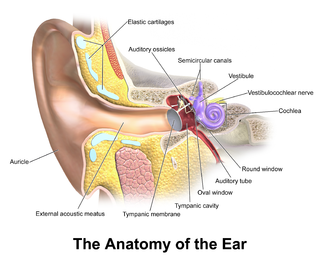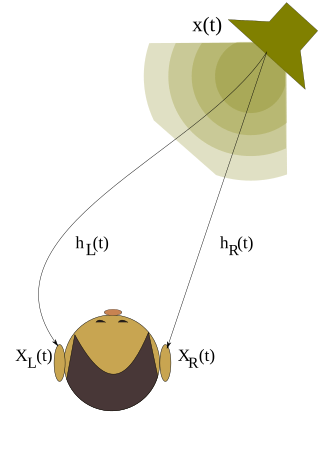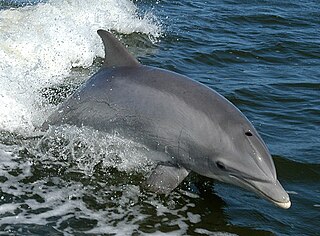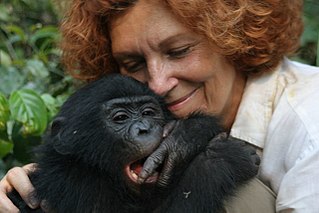Related Research Articles

A dolphin is an aquatic mammal within the infraorder Cetacea. Dolphin species belong to the families Delphinidae, Platanistidae, Iniidae, Pontoporiidae, and possibly extinct Lipotidae. There are 40 extant species named as dolphins.

In the anatomy of humans and various other tetrapods, the eardrum, also called the tympanic membrane or myringa, is a thin, cone-shaped membrane that separates the external ear from the middle ear. Its function is to transmit sound from the air to the ossicles inside the middle ear, and then to the oval window in the fluid-filled cochlea. Hence, it ultimately converts and amplifies vibration in the air to vibration in cochlear fluid. The malleus bone bridges the gap between the eardrum and the other ossicles.

A head-related transfer function (HRTF), also known as a head shadow, is a response that characterizes how an ear receives a sound from a point in space. As sound strikes the listener, the size and shape of the head, ears, ear canal, density of the head, size and shape of nasal and oral cavities, all transform the sound and affect how it is perceived, boosting some frequencies and attenuating others. Generally speaking, the HRTF boosts frequencies from 2–5 kHz with a primary resonance of +17 dB at 2,700 Hz. But the response curve is more complex than a single bump, affects a broad frequency spectrum, and varies significantly from person to person.

Whistled languages are linguistic systems that use whistling to emulate speech and facilitate communication between individuals.

Bottlenose dolphins are aquatic mammals in the genus Tursiops. They are common, cosmopolitan members of the family Delphinidae, the family of oceanic dolphins. Molecular studies show the genus definitively contains three species: the common bottlenose dolphin, the Indo-Pacific bottlenose dolphin, and Tamanend's bottlenose dolphin. Others, like the Burrunan dolphin, may be alternately considered their own species or be subspecies of T. aduncus. Bottlenose dolphins inhabit warm and temperate seas worldwide, being found everywhere except for the Arctic and Antarctic Circle regions. Their name derives from the Latin tursio (dolphin) and truncatus for their characteristic truncated teeth.

Oceanic dolphins or Delphinidae are a widely distributed family of dolphins that live in the sea. Close to forty extant species are recognised. They include several big species whose common names contain "whale" rather than "dolphin", such as the Globicephalinae. Delphinidae is a family within the superfamily Delphinoidea, which also includes the porpoises (Phocoenidae) and the Monodontidae. River dolphins are relatives of the Delphinoidea.

The toothed whales are a parvorder of cetaceans that includes dolphins, porpoises, and all other whales possessing teeth, such as the beaked whales and sperm whales. 73 species of toothed whales are described. They are one of two living groups of cetaceans, the other being the baleen whales (Mysticeti), which have baleen instead of teeth. The two groups are thought to have diverged around 34 million years ago (mya).

Cetacean intelligence is the overall intelligence and derived cognitive ability of aquatic mammals belonging in the infraorder Cetacea (cetaceans), including baleen whales, porpoises, and dolphins.

The common bottlenose dolphin or Atlantic bottlenose dolphin is a wide-ranging marine mammal of the family Delphinidae. In the order Cetacea, the common bottlenose is most similar to whales, porpoises, and other dolphins, and they are found in the waters around the globe. The common bottlenose dolphin is a very familiar dolphin due to the wide exposure it gets in captivity in marine parks and dolphinariums, and in movies and television programs. Spending their entire life in water, the common bottlenose inhabits temperate and tropical oceans throughout the world, absent only from polar waters. While formerly known simply as the bottlenose dolphin, this term is now applied to the genus Tursiops as a whole. As considerable genetic variation has been described within this species, even between neighboring populations, many experts think additional species may be recognized.

Animal languages are forms of non-human animal communication that show similarities to human language. Animals communicate through a variety of signs, such as sounds or movements. Signing among animals may be considered a form of language if the inventory of signs is large enough. The signs are relatively arbitrary, and the animals seem to produce them with a degree of volition. In experimental tests, animal communication may also be evidenced through the use of lexigrams by chimpanzees and bonobos.

Whales use a variety of sounds for communication and sensation. The mechanisms used to produce sound vary from one family of cetaceans to another. Marine mammals, including whales, dolphins, and porpoises, are much more dependent on sound than land mammals due to the limited effectiveness of other senses in water. Sight is less effective for marine mammals because of the particulate way in which the ocean scatters light. Smell is also limited, as molecules diffuse more slowly in water than in air, which makes smelling less effective. However, the speed of sound is roughly four times greater in water than in the atmosphere at sea level. As sea mammals are so dependent on hearing to communicate and feed, environmentalists and cetologists are concerned that they are being harmed by the increased ambient noise in the world's oceans caused by ships, sonar and marine seismic surveys.

An ear is the organ that enables hearing and body balance using the vestibular system. In mammals the ear is usually described as having three parts: the outer ear, the middle ear and the inner ear. The outer ear consists of the pinna and the ear canal. Since the outer ear is the only visible portion of the ear in most animals, the word "ear" often refers to the external part alone. The middle ear includes the tympanic cavity and the three ossicles. The inner ear sits in the bony labyrinth, and contains structures which are key to several senses: the semicircular canals, which enable balance and eye tracking when moving; the utricle and saccule, which enable balance when stationary; and the cochlea, which enables hearing. The ear is a self cleaning organ through its relationship with earwax and the ear canals. The ears of vertebrates are placed somewhat symmetrically on either side of the head, an arrangement that aids sound localization.
Sound localization is a listener's ability to identify the location or origin of a detected sound in direction and distance.

Human–animal communication is the communication observed between humans and other animals, ranging from non-verbal cues and vocalizations to the use of language.

Hearing range describes the frequency range that can be heard by humans or other animals, though it can also refer to the range of levels. The human range is commonly given as 20 to 20,000 Hz, although there is considerable variation between individuals, especially at high frequencies, and a gradual loss of sensitivity to higher frequencies with age is considered normal. Sensitivity also varies with frequency, as shown by equal-loudness contours. Routine investigation for hearing loss usually involves an audiogram which shows threshold levels relative to a normal.

A perforated eardrum is a hole in the eardrum. It can be caused by infection, trauma, overpressure, inappropriate ear clearing, and changes in middle ear pressure. An otoscope can be used to view the eardrum to diagnose a perforation. Perforations may heal naturally or require surgery.
In the study of the biological sciences, biocommunication is any specific type of communication within (intraspecific) or between (interspecific) species of plants, animals, fungi, protozoa and microorganisms. Communication basically means sign-mediated interactions following three levels of rules. Signs in most cases are chemical molecules (semiochemicals), but also tactile, or as in animals also visual and auditive. Biocommunication of animals may include vocalizations, or pheromone production, chemical signals between plants and animals, and chemically mediated communication between plants and within plants.
William Tecumseh Sherman Fitch III is an American evolutionary biologist and cognitive scientist at the University of Vienna where he is co-founder of the Department of Cognitive Biology.
David Hurst Batteau is an American singer-songwriter. Batteau is the son of Blanca Batteau and Dr. Dwight Wayne Batteau, of Harvard University and Tufts University. He is the brother of singer-songwriters Robin Batteau and Dwight Jr.
Robin Batteau is an American composer, singer-songwriter, and music producer. Batteau is the son of Blanca Batteau and Dr. Dwight Wayne Batteau, and brother of singer/songwriter David Batteau. He attended Phillips Academy in Andover and should have graduated from Harvard University in 1969, but actually finished his degree in 2021. Batteau worked with his brother David as Batteaux, releasing one album on Columbia Records in 1971. He performed with David Buskin as Buskin and Batteau but in April 2014 the duo split up. He recorded with Tom Rush. Batteau was awarded the Kate Wolf Memorial Award by the World Folk Music Association in 1991.
References
- ↑ "The Ears Have It," Newsweek 1961-12-04, pp.80-81
- ↑ Batteau, Dwight Wayne (January 1964). "The role of the pinna in human localization" (PDF). Proceedings of the Royal Society of London, B Biological Sciences. Retrieved 2023-11-30.
- ↑ Batteau, Dwight Wayne (2023-11-30). "Google Scholar". scholar.google.com. Retrieved 2023-12-01.
- ↑ Einhorn, Richard N. (1967-12-06). "Special Report - Dolphins challenge the designer" (PDF). Electronic Design 25. Retrieved 2023-11-30.
- ↑ Herzing, Denise L. (November 2016). "Interfaces and Keyboards for Human-Dolphin Communication: What Have We Learned?" (PDF). Animal Behavior and Cognition. Retrieved 2023-11-30.
- ↑ Moshier, Stephen L. (1967-12-13). "Technical Manual MDT-5. Final Report, Appendix A, U. S. Navy Contract N00123-67-C-1103" (PDF). US Navy. Retrieved 2023-11-30.
- ↑ Batteau, Dwight W., and Peter R. Markey (1967-12-13). "Man/Dolphin Communication. Final Report, U. S. Navy Contract N00123-67-C-1103" (PDF). US Navy. Retrieved 2023-11-30.
{{cite web}}: CS1 maint: multiple names: authors list (link) - ↑ "Dwight W Batteau, "United States World War II Army Enlistment Records, 1938-1946". www.familysearch.org. 2014-12-05. Retrieved 2023-12-01.
- ↑ "US Army Reserve Officers 1942-1945t". accident-report.com. Retrieved 2023-12-01.
- 1 2 "Obituary, Dr. Wayne Batteau". The New York Times. 1967-10-30. Retrieved 2023-12-01.
- ↑ Reinhold, Robert (1970-11-18). "Vonnegut Has 15 Nuggets of Talent in Harvard Class". NY Times. Retrieved 2023-11-30.
- ↑ Bingham, Andrew W., and Robert H. Neuman (1956-11-02). "Science Fiction Does Not Mean Spaceship Cowboys". Harvard Crimson. Retrieved 2023-12-01.
{{cite web}}: CS1 maint: multiple names: authors list (link) - ↑ "The Journal of Engineering Education 1954-09: Vol 45 Issue 1 page 94". Journal of Engineering Education. Blackwell Publishing Ltd. September 1954. Retrieved 2023-12-01.
- ↑ "Transactions of the New York Academy of Science 1962-01: Vol 24 Issue 3 page 336". NY Academy of Sciences. New York Academy of Sciences. January 1962. Retrieved 2023-12-01.
- ↑ Batteau, Dwight W. (1965-11-23). "Batteau Studies Molecular Basis For Sensation" (PDF). Tufts Weekly. Retrieved 2023-11-30.